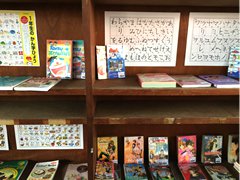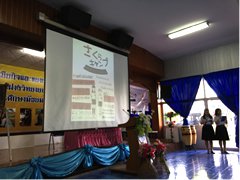Developing Japanese-Language Teachers for Elementary and Lower Secondary School Education in Thailand
Khon Kaen University
HONDA Michiko
Notable Features of the Teaching Japanese Language Course (hereinafter “the TJL course”) at the Faculty of Education, Khon Kaen University
Khon Kaen University is the largest university in Northeast Thailand, with 40,000 students across 17 faculties. The campus within Khon Kaen City is very large, and covers 90 square kilometers. (As a reference, that is reportedly equivalent to around 192 Tokyo Domes). To enable people to get around the university, buses travel the length and breadth of the campus. The university attracts students from throughout Thailand, centering on the Northeast region, and they live in dormitories and apartments in the vicinity, giving rise to a large student town surrounding the university.
In Thailand, as a result of Japanese being included as a foreign language subject at secondary school education (this covers a six-year period equivalent to junior high and high school in Japan), the number of Japanese-language learners has grown significantly. Early on, in many cases teachers of other subjects such as mathematics and English underwent training to teach Japanese, but in recent years, individuals who have majored in the Japanese language at university have been becoming teachers. The TJL course is now the only education department that develops Japanese-language teachers in Thailand. The TJL course currently contains 147 students who are studying with the aim of becoming Japanese-language teachers. They cite a variety of reasons for choosing the Japanese language from among the numerous subjects on offer, including because they studied the Japanese language at secondary school or that they like Japan’s subculture. However, many of the students say they want to become teachers because it was recommended to them by their parents, who are working as teachers, and this is perhaps a typically Thai response. Although the TJL course is a Japanese-language major, because it is part of the Faculty of Education, alongside studying Japanese in the classroom, the students frequently visit elementary and lower secondary schools to take part in activities there. Here, I would like to introduce the off-campus activities of students aiming to become Japanese-language teachers.
Teaching Practice
Once the students complete their course credits across four years at university, they enter a one-year teacher trainee period at an elementary or lower secondary education institution. You could say that the students have been continuously preparing for teaching practice over the four-year period since entering university, so this is the long-awaited teacher trainee period. They take a range of education-related lessons, which naturally include Japanese-language teaching methods and how to write a lesson plan, and accumulate hands-on training.

A book corner put together by a teacher trainee
Teacher trainees take classes under the guidance of mentor teachers at the schools where they train, and help with events and so on to gain experience of a range of school duties. Additionally, there are regular days each month when they return to university to give reports and receive instruction. Furthermore, TJL course instructors visit the trainees’ training schools four times over the course of the period to evaluate the trainees’ classes. The trainees also prepare graduation theses that sum up their experiences at the training schools. Unless all of these components are completed, they are unable to graduate. For the teacher trainees, it is a tough year even physically, but by the time the training ends they have faced up to hardships not only as students but as working adults, they have deepened their interaction with the students in their charge, and they have become able to present magnificent lessons even in the classroom. The one year of practical teaching training could be described as the most testing year for both the students and the TJL instructors.
Japanese-Language Camp

University students moderating an event
One of the events that TJL students undertake regularly outside of classes is a Japanese-language camp. The TJL students hold this event at elementary and lower secondary education institutions where there are no full-time Japanese-language teachers or where Japanese-language classes are not offered, in order to showcase Japan and the Japanese language. Since the question of what foreign language subjects are adopted by school is left up to school principals, in some cases this event leads to schools beginning Japanese-language learning, and consequently the students make the utmost effort. They coordinate the event while skillfully enlivening the mood by holding quizzes, demonstrating dances, letting participants try on yukata (Japanese summer kimono) and so on. Events such as this are not just Japanese-language promotion activities – because they also get the students accustomed to standing in front of people, there is also a clear connection to the goal of becoming a teacher.
In Order to Popularize Japanese-Language Learning
Many Japanese companies operate businesses in Thailand, and the country is also visited by a large number of Japanese tourists. Most of the cars by far that drive around the streets of Khon Kaen, the northeast region’s central city, are Japanese cars. Home appliances and food products from Japanese brands are also common in stores, so you get a real sense that Japan is an accepted part of residents’ lives. Undoubtedly, if the Thai children for whom Japan is a familiar part of everyday life went a step further by experiencing Japanese-language learning at school, it would be an opportunity for them to get to know Japan more deeply. Countries’ education policies and foreign language education methods also change with the times. By continuing to make straightforward, cumulative efforts, day by day, I hope to ensure that TJL produces the new generation of Japanese-language teachers.
- What We Do Top
- Arts and Cultural Exchange [Culture]
- Japanese-Language Education Overseas [Language]
- Japanese-Language Education Overseas [Language] Top
- Learn Japanese-language
- Teach Japanese-language
- Take Japanese-Language Test
- Know about Japanese-language education abroad
- The Japanese-Language Institute, Urawa
- The Japanese-Language Institute, Kansai
- Japanese-Language Programs for Foreign Specified Skilled Worker Candidates
- Japanese Language Education for Japanese Children Resident Overseas and for the Descendants of Migrants
- Archives
- Japanese Studies and Global Partnerships [Dialogue]
- JF digital collection
- Other Programs / Programs to Commemorate Exchange Year
- Awards and Prizes
- Publications
